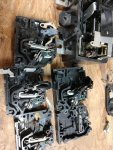I am deeply immersed in issues related to this right now.
H
2S gas is produced by anything that is "rotting", including animal (and human animal) waste. When H
2S gas mixes with water, it forms H
2SO
4, aka sulfuric acid, one of the most virulent acids when it comes to corrosion. Sulfuric acid then eats into most exposed metal surfaces. One nasty aspect of this that is affecting everyone now and for the foreseeable future is that RoHS rules (Reduction of Hazardous Substances) for electronics assemblies have removed lead from the PC boards now. Lead oxide was one of the few materials not affected much by H
2SO
4 so when things like the "fingers" on PC board edge connectors were cut, exposing the lead substrate, the lead oxide that formed was protecting the gold plating on those fingers from the H
2SO
4. Now that the lead is gone, newer electronic assemblies are corroding much faster and failing sooner. Most mfrs now put what's called "conformal coating" on their PC boards, but they can't coat those edge connectors.
In addition (and more related to circuit breakers) H
2S, when exposed to silver, causes the growth of "
whiskers" of silver nitrate to form on the surfaces and they grow over time. When that happens inside of circuit breakers on silver plated current carrying parts such as contacts, nobody notices so long as the breakers are closed. But when they open, the silver whiskers span the air gap that is supposed to interrupt current flow and you get an internal flashover. Sometimes if it's just a little bit of the whiskers, that just looks like a flash and they vaporize without causing much damage. But every now and then the build-up is significant enough that the flashover is destructive to the breaker.
The answer is that the user must use a positive air pressurization system, making sure that the source of air is far away from the source of H
2S, or if not possible, install a "scrubber" system for their location. I have seen an entire MCC in a pump station literally dissolve when a scrubber system failed and had no alarm system to tell anyone. On top of that problem, H
2S is a severe health hazard in high concentrations (as it was in that case) so someone could have been seriously harmed.
H
2S air scrubber...
http://mvseer.com/technologies/h2s-removal-systems/h2splus-system/


